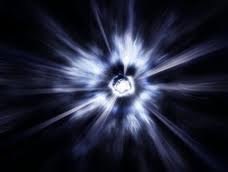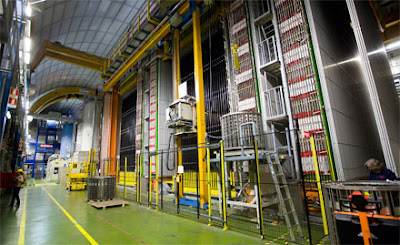Scientists Break The Speed Of Light -Overturns Einstein's 1905 Theory Of Special Relativity
科學家打破光速 - 推翻愛因斯坦1905年的狹義相對論
2011-09-23
OPERA實驗報告:中微子從歐洲核子研究中心往格蘭薩索以異常快於光飛行時間
OPERA Experiment Reports Anomaly In Faster Than Light Flight Time Of Neutrinos From CERN To Gran Sasso
Friday, September 23, 2011
Translation by Autumnson Blog
The OPERA1 experiment, which observes a neutrino beam from CERN2 730 km away at Italy’s INFN Gran Sasso Laboratory, will present new results in a seminar at CERN this afternoon at 16:00 CEST. The seminar will be webcast at http://webcast.cern.ch. Journalists wishing to ask questions may do so via twitter using the hash tag #nuquestions, or via the usual CERN press office channels.
OPERA1的實驗,是在意大利的INFN格蘭薩索實驗室觀察一中微子束來自730公里外的CERN2,新結果將在今天下午16:00 CEST時在歐洲核子研究中心的一個研討會上介紹。此次研討會將在http://webcast.cern.ch/.作網上直播。記者想要提問可通過 Twitter使用散列標籤#nuquestions這樣做,或透過平時的CERN新聞辦公室渠道。
The OPERA result is based on the observation of over 15000 neutrino events measured at Gran Sasso, and appears to indicate that the neutrinos travel at a velocity 20 parts per million above the speed of light, nature’s cosmic speed limit. Given the potential far-reaching consequences of such a result, independent measurements are needed before the effect can either be refuted or firmly established. This is why the OPERA collaboration has decided to open the result to broader scrutiny. The collaboration’s result is available on the preprint server arxiv.org: http://arxiv.org/abs/1109.4897.
Credit :CERN
A view of the OPERA detector in Gran Sasso, Italy. Neutrino beams from CERN in Switzerland are sent over 700km through the Earth's crust to the laboratory in Italy.
意大利格蘭薩索的OPERA探測器一覽;中微子束從瑞士歐洲核子研究中通心過地球地殼被送到700公里外的意大利實驗室。
The OPERA measurement is at odds with well-established laws of nature, though science frequently progresses by overthrowing the established paradigms. For this reason, many searches have been made for deviations from Einstein’s theory of relativity, so far not finding any such evidence. The strong constraints arising from these observations makes an interpretation of the OPERA measurement in terms of modification of Einstein’s theory unlikely, and give further strong reason to seek new independent measurements.
“This result comes as a complete surprise,” said OPERA spokesperson, Antonio Ereditato of the University of Bern. “After many months of studies and cross checks we have not found any instrumental effect that could explain the result of the measurement. While OPERA researchers will continue their studies, we are also looking forward to independent measurements to fully assess the nature of this observation.”
“When an experiment finds an apparently unbelievable result and can find no artefact of the measurement to account for it, it’s normal procedure to invite broader scrutiny, and this is exactly what the OPERA collaboration is doing, it’s good scientific practice,” said CERN Research Director Sergio Bertolucci. “If this measurement is confirmed, it might change our view of physics, but we need to be sure that there are no other, more mundane, explanations. That will require independent measurements.”
In order to perform this study, the OPERA Collaboration teamed up with experts in metrology from CERN and other institutions to perform a series of high precision measurements of the distance between the source and the detector, and of the neutrinos’ time of flight. The distance between the origin of the neutrino beam and OPERA was measured with an uncertainty of 20 cm over the 730 km travel path. The neutrinos’ time of flight was determined with an accuracy of less than 10 nanoseconds by using sophisticated instruments including advanced GPS systems and atomic clocks. The time response of all elements of the CNGS beam line and of the OPERA detector has also been measured with great precision.
"We have established synchronization between CERN and Gran Sasso that gives us nanosecond accuracy, and we’ve measured the distance between the two sites to 20 centimetres,” said Dario Autiero, the CNRS researcher who will give this afternoon’s seminar.
“Although our measurements have low systematic uncertainty and high statistical accuracy, and we place great confidence in our results, we’re looking forward to comparing them with those from other experiments."
“The potential impact on science is too large to draw immediate conclusions or attempt physics interpretations. My first reaction is that the neutrino is still surprising us with its mysteries.” said Ereditato. “Today’s seminar is intended to invite scrutiny from the broader particle physics community.”
1. OPERA has been designed and is being conducted by a team of researchers from Belgium, Croatia, France, Germany, Israel, Italy, Japan, Korea, Russia, Switzerland and Turkey. The experiment constitutes a complex scientific enterprise that has been realised thanks to the skill of a large number of scientists, engineers, technicians and students, and with the strong commitment of the various actors of the project. In particular we mention the LNGS/INFN and CERN laboratories, and the major financial support of Italy and Japan with substantial contributions from Belgium, France, Germany and Switzerland. The OPERA Collaboration presently includes about 160 researchers from 30 institutions and 11 countries:IIHE-ULB Brussels, Belgium; IRB Zagreb, Croatia; LAPP Annecy, France; IPNL Lyon, France; IPHC Strasbourg, France; Hamburg, Germany; Technion Haifa, Israel; Bari, Italy; Bologna, Italy; LNF, Italy, L’Aquila, Italy; LNGS, Italy; Naples, Italy; Padova, Italy; Rome, Italy; Salerno, Italy; Aichi, Japan; Toho, Japan; Kobe, Japan; Nagoya, Japan; Utsunomiya, Japan; GNU Jinju, Korea; INR RAS Moscow, Russia; LPI RAS Moscow, Russia; ITEP Moscow, Russia; SINP MSU Moscow, Russia; JINR Dubna, Russia; Bern, Switzerland; ETH Zurich, Switzerland; METU Ankara, Turkey.2. CERN, the European Organization for Nuclear Research, is the world's leading laboratory for particle physics. It has its headquarters in Geneva. At present, its Member States are Austria, Belgium, Bulgaria, the Czech Republic, Denmark, Finland, France, Germany, Greece, Hungary, Italy, the Netherlands, Norway, Poland, Portugal, Slovakia, Spain, Sweden, Switzerland and the United Kingdom. Romania is a candidate for accession. India, Israel, Japan, the Russian Federation, the United States of America, Turkey, the European Commission and UNESCO have Observer status.
2. CERN, the European Organization for Nuclear Research, is the world's leading laboratory for particle physics. It has its headquarters in Geneva. At present, its Member States are Austria, Belgium, Bulgaria, the Czech Republic, Denmark, Finland, France, Germany, Greece, Hungary, Italy, the Netherlands, Norway, Poland, Portugal, Slovakia, Spain, Sweden, Switzerland and the United Kingdom. Romania is a candidate for accession. India, Israel, Japan, the Russian Federation, the United States of America, Turkey, the European Commission and UNESCO have Observer status.
Source: CERN
http://nanopatentsandinnovations.blogspot.com/
驚天大發現 挑戰相對論中微子超光速 愛因斯坦錯了?
2011-09-24
「宇宙中沒有任何物體可以快過光速。」愛因斯坦( Albert Einstein)在相對論提出光速是速度的極限,過去一世紀被物理學家奉為基本定律。可是歐洲科學家卻測出中微子( neutrino)的移動速度,竟比光速快,假如這發現獲確認,不但代表愛因斯坦錯了,還意味物理學將出現翻天覆地改變。
科學家過去三年在法國和瑞士邊境的歐洲核子研究中心( CERN),向 730公里外的意大利大薩索( Gran Sasso)實驗室,發射了 15,000束中微子,由巨型偵測器接收,計算出中微子移動速度是每秒 300,006公里,比光速每秒 299,792公里略快,中微子抵達時間比光速早了 60納秒( 1納秒是 10億分之一秒),實驗誤差不足 10納秒。
邀美日實驗室再驗證
研究員發言人埃雷迪塔托( Antonio Ereditato)說:「結果完全出人意料。我們只是想量度中微子的速度,從沒預期會有任何特別發現。」他指研究員花了半年,反覆檢查細節、再測試和計算,確認完全沒有問題後,前天(周四)才公佈發現,仍非常審慎地在網上公開實驗數據,邀請同行覆核,並希望美國和日本的實驗室做獨立實驗,驗證能否得出同一結果。
世上竟有東西快過光,令全球物理學家哄動,不少人堅信該實驗有系統性誤差未發現,更有人說願拿自己的屋來打賭。英國著名物理學家霍金( Stephen Hawking)說:「目前作出評論仍是言之過早,需作進一步實驗和闡釋。」
愛因斯坦 1905年在狹義相對論指出,真空中的光速是「宇宙常數」,沒有物件可快過光。根據他著名的 E=MC方程式,一件物體要達到光速,就已需要無限大的能量。法國物理學家比內特呂說,如超光速發現獲證實,不只狹義和廣義相對論受挑戰,所有物理學家都要重新學習和思考宇宙如何運作。
中微子是種非常小的次原子粒子,不帶電荷,雖然 1934年已證實存在,但一直為物理學家帶來困惑,像它在恒星核聚變或輻射衰變產生,數量非常多,卻非常難被偵測,又可輕易穿過大部份物質而不受影響,被稱為「幽靈粒子」,到近年才發現有微量質量。
法新社/路透社/英國《泰晤士報》
http://hk.apple.nextmedia.com/template/apple/art_main.php?iss_id=20110924&sec_id=15335&art_id=15642777
粒子超光速 挑戰相對論 歐實驗發現 專家審慎
明報 – 16小時前
明報專訊】歐洲研究人員周四宣布,在實驗中發現有「鬼粒子」之稱的中微子,其速度能夠比光速更快,挑戰愛因斯坦「相對論」強調沒有物質能夠快過光速的物理學最根本定律之一,消息惹來國際物理學界議論紛紛,因為若發現屬實,將改寫人類對宇宙和時空的認識,甚至再掀時光旅行是否可行的爭論。但無論是科學界還是負責今次研究的專家,都對今次實驗得出的發現,持謹慎態度,希望全球科學家能共同探究原因,包括實驗是否有錯。
實驗是由意大利格蘭薩索(Gran Sasso)國家實驗室,以及位於瑞士的全球最大粒子物理研究實驗室「歐洲核子研究中心」(European Centre for Nuclear Research, CERN)合作進行。CERN在日內瓦附近的地下粒子加速器,會發射出能夠貫穿地底的中微子,而意大利格蘭薩索實驗室,則利用一個名為OPERA的地下偵測裝置,嘗試「捕捉」這些中微子。宇宙中存在大量中微子(neutrino),但很難觀測,因此有「鬼粒子」稱號。
「鬼粒子」穿透力強 快光速0.0025%
經過3年實驗努力,意大利研究員合共偵測到近1.6萬個由CERN射來的中微子。研究員表示,兩地相距730公里,理論上光要花2.3毫秒(1毫秒即千分一秒)才能跑完,但他們發現,射來的中微子,比光速還快了60納秒(1納秒即十億分一秒),誤差少於10納秒。換言之,光速每秒為接近30萬公里,但中微子每秒能比其跑多6公里;中微子比光速還要快0.0025%。
反覆1.6萬次 推翻愛因斯坦言之尚早
愛因斯坦20世紀初發表的「相對論」認為,沒有任何物體的速度能超越光速,這成為當代物理學的重要基礎。若真的證實這種超光速現象,整個物理學理論體系或許會因之重建。由於事關重大,科學界對今次超光速實驗結果都持謹慎態度,《紐約時報》指出,物理學家的初步反應,都認為說「愛因斯坦錯了」為時尚早,認為更有可能的是實驗出了錯。
參與實驗的瑞士伯爾尼大學的伊拉蒂塔托(Antonio Ereditato)坦言,他和同事都對實驗結果大感震驚,「雖然速度差異極小,但概念上極其重要」,他們反覆觀測到這現象近1.6萬次,認為這觀測結果站得住腳,才決定將其公開,而目的正是讓同行幫助,仔細審視實驗是否有漏洞。他說:「我們已不斷檢查和覆查(實驗中)任何可能扭曲測量的因素,但什麼也沒找到。我的夢想是另有獨立實驗發現相同的事,那我就安心了。」
http://hk.news.yahoo.com/%E7%B2%92%E5%AD%90%E8%B6%85%E5%85%89%E9%80%9F-%E6%8C%91%E6%88%B0%E7%9B%B8%E5%B0%8D%E8%AB%96-%E6%AD%90%E5%AF%A6%E9%A9%97%E7%99%BC%E7%8F%BE-%E5%B0%88%E5%AE%B6%E5%AF%A9%E6%85%8E-213352681.html
透過展示單一的光子不能以超越光速旅行,香港科學家證明時間旅行是不可能的
多位諾貝爾物理學獎獲得者質疑光速被打破實驗
新實驗証實中微子未超光速 愛因斯坦相對論正確





沒有留言:
發佈留言